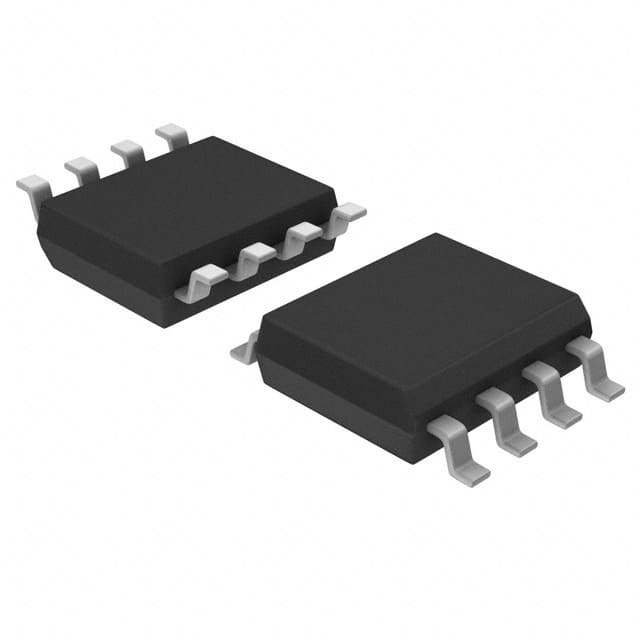Lihat spesifikasi untuk detail produk.

TCAN1051HVD
Product Overview
Category
TCAN1051HVD belongs to the category of high-speed CAN transceivers.
Use
It is primarily used for communication in automotive and industrial applications.
Characteristics
- High-speed communication: TCAN1051HVD supports data rates up to 5 Mbps.
- Robustness: It provides excellent electromagnetic compatibility (EMC) performance, making it suitable for harsh environments.
- Low power consumption: The transceiver operates with low power consumption, enhancing energy efficiency.
- Temperature range: It can operate within a wide temperature range, typically from -40°C to +125°C.
Package
The TCAN1051HVD comes in a small outline integrated circuit (SOIC) package.
Essence
The essence of TCAN1051HVD lies in its ability to facilitate reliable and efficient communication over a high-speed CAN bus.
Packaging/Quantity
The transceiver is typically available in reels containing a specified quantity, such as 2500 units per reel.
Specifications
- Supply voltage: 4.5V to 5.5V
- Operating temperature range: -40°C to +125°C
- Data rate: Up to 5 Mbps
- ESD protection: ±8 kV HBM, ±15 kV IEC 61000-4-2 contact discharge
Detailed Pin Configuration
The TCAN1051HVD has the following pin configuration:
- VCC
- GND
- RS
- CANL
- CANH
- VREF
- TXD
- RXD
- STB
Functional Features
- High-speed CAN communication
- Integrated protection against electrostatic discharge (ESD)
- Low power consumption in standby mode
- Wake-up capability through dominant time-out detection
- Thermal shutdown protection
Advantages and Disadvantages
Advantages
- High-speed data transmission
- Robustness in harsh environments
- Low power consumption
- Wide operating temperature range
Disadvantages
- Limited compatibility with lower-speed CAN protocols
- Relatively higher cost compared to standard transceivers
Working Principles
TCAN1051HVD operates as a high-speed CAN transceiver by converting the differential signals on the CAN bus into digital signals that can be processed by the connected microcontroller or other devices. It ensures reliable communication by providing ESD protection, thermal shutdown, and wake-up capabilities.
Detailed Application Field Plans
TCAN1051HVD finds applications in various fields, including: - Automotive: Used in automotive electronic control units (ECUs) for communication between different vehicle systems. - Industrial automation: Enables communication between industrial devices and controllers in manufacturing processes. - Robotics: Facilitates communication between different components of robotic systems. - Energy management systems: Used for communication in smart grid systems and energy management applications.
Alternative Models
Some alternative models to TCAN1051HVD include: - SN65HVD1050 - MCP2551 - TJA1050 - PCA82C250
These models offer similar functionality and are widely used in the industry.
In conclusion, TCAN1051HVD is a high-speed CAN transceiver designed for automotive and industrial applications. Its robustness, low power consumption, and wide temperature range make it suitable for demanding environments. While it has some limitations, it offers reliable communication and is widely used in various fields.
Sebutkan 10 pertanyaan dan jawaban umum terkait penerapan TCAN1051HVD dalam solusi teknis
Sure! Here are 10 common questions and answers related to the application of TCAN1051HVD in technical solutions:
1. What is TCAN1051HVD? - TCAN1051HVD is a high-speed CAN transceiver that provides an interface between a Controller Area Network (CAN) protocol controller and the physical two-wire CAN bus.
2. What is the maximum data rate supported by TCAN1051HVD? - TCAN1051HVD supports data rates up to 5 Mbps, making it suitable for high-speed CAN applications.
3. Can TCAN1051HVD be used in automotive applications? - Yes, TCAN1051HVD is designed to meet the requirements of automotive applications and is compliant with ISO11898-2 and ISO11898-5 standards.
4. Does TCAN1051HVD support extended frame format? - Yes, TCAN1051HVD supports both standard and extended frame formats, allowing for flexibility in different CAN network configurations.
5. What is the operating voltage range of TCAN1051HVD? - TCAN1051HVD operates from a supply voltage range of 4.5V to 5.5V, which is commonly used in many electronic systems.
6. Can TCAN1051HVD be used in industrial automation applications? - Yes, TCAN1051HVD is suitable for industrial automation applications due to its robustness, ESD protection, and wide temperature range (-40°C to +125°C).
7. Does TCAN1051HVD have built-in fault protection features? - Yes, TCAN1051HVD includes various fault protection features such as thermal shutdown, undervoltage lockout, and overvoltage protection.
8. Can TCAN1051HVD be used in multi-node CAN networks? - Yes, TCAN1051HVD can be used in multi-node CAN networks by connecting multiple transceivers to the same CAN bus.
9. Is TCAN1051HVD compatible with other CAN controllers? - Yes, TCAN1051HVD is compatible with a wide range of CAN controllers and can be easily integrated into existing CAN systems.
10. What is the typical quiescent current consumption of TCAN1051HVD? - The typical quiescent current consumption of TCAN1051HVD is very low, typically around 5 µA, making it suitable for power-sensitive applications.
Please note that these answers are general and may vary depending on specific application requirements.

